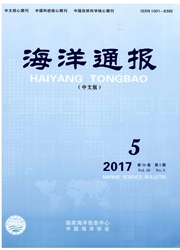

 中文摘要:
中文摘要:
根据2011年7月3日-4日在苦水洋海域获取的全潮水文资料和底质样品,计算潮周期水、沙输运率,分析了其沉积动力特征。基于1979年历史海图资料与最新测量的水道地形进行对比,进一步探讨苦水洋水道的地形演变过程及稳定性。结果表明,苦水洋潮流作用较强,水道内沉积物主要以悬移质形式输运,在近岸段沿水道向岸净输沙,但在(121.606°E,33.029°N)以东以向海输运为主。近三十多年来,苦水洋西水道深槽与口门北水道逐渐贯通,水道整体趋于顺直。
 英文摘要:
英文摘要:
Based on the data from hydrological observation and sediment sampling in Kushuiyang during a tide cycle from 3rd July 2011 to 4th July 2011, the water and sediment transport rates are calculated to specify the sediment dynamic characteristics along the tidal channel. The geomorphological evolution and stability of the channel are also discussed on the basis of the comparison between historic sea charts and new topographic surveys. The main results turn out that tidal currents are strong in the channel. Sediments are mainly transported in the form of suspended loads. The net transport direction is landward in the nearshore part of channel, while it is generally pointed seaward in the part of channel east of sand bank (121.606°E, 33.029°N). Over the past thirty years, the deep trough of west Kushuiyang channel has gradually connected to the north part of channel, leading the whole channel to be straighter.
 同期刊论文项目
同期刊论文项目
 同项目期刊论文
同项目期刊论文
 期刊信息
期刊信息
